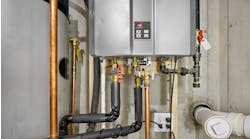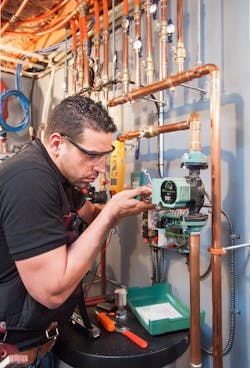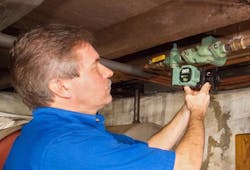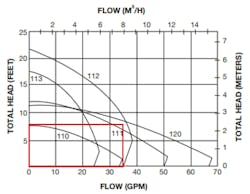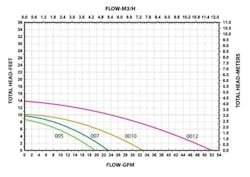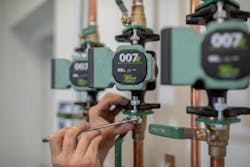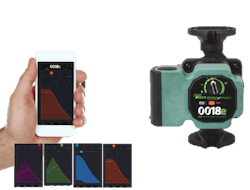I like it when someone approaches a topic uniquely, from a different perspective. Whether it’s a book I read, an educational class that’s offered… or even one that I might provide to folks in the hydronics industry. So, for a recent installer seminar that I had the good fortune to lead, I decided to try a different approach.
Let’s all agree that hydronic systems—given a good, workable design and the right components, properly installed—can work really well, provide great comfort, and last a long time. But the reality is components, including circulators, eventually tire. I’m regularly told by installers that our circs and pumps are still working after 20, 30 or 40 years. But, they won’t last forever!
At Taco, co-instructors John Barba, Rick Mayo and I acknowledge that there’s always a math component to calculating the performance of a replacement circulator. The math verifies and assures your choice of the right circulator—and helps installers avoid the wrong selection. If you do the math, you can never, ever be wrong.
But I Don’t Wanna Do the Math!
What can installers do if they don’t wanna do the math? Or maybe they haven’t yet studied that facet of performing a replacement, taken the class, a Taco Tuesday webinar, or tuned in to our Taco After Dark learning sessions.
That’s where my desire to offer a new approach comes in: how to choose the right replacement circ without, dare I say, doing the math.
To answer that question, let’s take a step back. Consider the classics. Think back in time to those good ol’ “pork-chop boiler” days before our 00 Series. For many, the classic wet rotor circulator might be the B&G 100. Now, there’s a circ that cut a trail, and decorated many mechanical rooms back in its day.
Taco’s comparable circ was the Taco 110 series, still in production today—even though there are smaller wet rotor replacements that can do the same job better and require less energy. Why would an installer want an exact replacement? Well, because it was on a job site for 40 years and some trade pros want the exact same one again. But remember: it’s the performance of the old circulator that we’d want to replicate—not necessarily the circ itself. The performance curve defines its capability. And if you can get that with a smaller, much more efficient circ, wouldn’t you prefer it?
With performance, we’re talking about the chart that provides a glimpse of the flow in gallons per minute across the bottom, and the total feet of head along the left-hand side. Those curves represent what that circulator’s flow and head range are—the real measurement of a circulator’s capability—so understanding the differences in the curves is the important part.
Some circulators provide a steep curve which is going to be very high head and very low flow, versus a flat curve which is going to be low head with very high gallons per minute.
The ol’ Taco “Red Baron” 110—an in-line circ with 3-piece cast iron body, and the B&G100—are flat curve circulators with very high flow. The 110 can produce up to 35 gallons a minute, and the B&G 100, up to 33 gallons a minute—but it only produced about six or seven feet of head. But that’s ideal for those single zone systems with big pipes that were installed back in the 50s, 60s and 70s. By today’s standard that’s a lot of water movement.
All that to say: it’s important to pay attention to the performance curves.
Keep in mind, too, that some curves can initially be misleading in the way they appear on the page. Look closely. The image of a performance curve might look like a steep curve. But it's all relative to the flowing gallons per minute, so some of the manufacturers might squish that curve down so it fits on the paper. But the numbers tell it like it is. That’s what’s important.
The big difference between wet rotor circulators today (meaning that the water moving through the circ also lubricates its parts) may not extend all the way out to 35 gallons a minute. Perhaps it’s top end is only 25 gallons a minute with 8 or 9 feet of head. The new circs might do the job—that is, moving sufficient water to distribute enough heat just fine—but again, the important thing is to inspect the performance curve closely.
So, could a small Taco 007 do the job sufficiently? If you look at our current, flat curve generation of circs—including the 005, 007, 0010 and the 0012—you might find what you’re looking for. The 005 moves up to 20 gpm. The 007 maxes out at 23 gpm. The 0010 moves up to 33 gallons a minute, and the 0012 can achieve 52 gpm, but only reaches a maximum of 14 feet of head.
Other Considerations
But there are times when installers want exactly what the old B&G circ did, performance-wise.
If that’s the case, let’s consider the piped system. Is the piping three-quarter or one-inch copper or steel pipe? Was the old circ performing at maximum flow—say, 10 or 12 gallons a minute? Would the Taco 0010 be a decent substitute? Perhaps… but if we look at the pipe size feeding the zone, that could tell us a lot, including whether or not a smaller circulator can be used. To achieve safe, trouble-free design with optimal flow rates for hot water piping, I use this chart from Dan Holohan’s book, Pumping Away:
¾” = 4 GPM
1” = 8 GPM
1-1/4” = 14 GPM
1-1/2” = 22 GPM
What this tells me: if you have a system that’s piped with 1”, your maximum flow rate should be around 8 gallons per minute. Now ask yourself, do you need a circ that can produce over 30 gallons per minute when you can only use 8 and still heat the house?
Yes, you could. But is it best-suited for the job? Probably not.
Either way—whether you use a circ well-suited to the task, or one that’s capable of much more—make sure you match the shape of the curve when selecting the new circulator.
What if you don’t have a 60-year-old, three-piece circulator but you have something from the 70s, 80s or 90s? I get calls frequently from installers asking me about replacing specific circs when the exact replacement can’t be found. Say, for instance, a 007-F3. But, at the wholesaler, only a 007-F5 can be in their hands that day.
The short answer is: there are no F3’s out there unless they're installed in somebody's project. Taco stopped making them years ago. Changes were made in the manufacturing—and because of that, some of the numbers and letters after the “00” may have changed. The performance is still the same. Match the “00” number and the fit, and all will be well in the world of your customer’s comfort. The key is to compare performance curves.
With a three-speed circ, the question then becomes what speed to set it at, right? The answer is the one that best replicates the performance curve you’re hoping for. And that’s truly the best way to make the decision.
I can assure you it’s much better than a guess on your part, or simply making a quick decision to set it on its highest speed—the one we’ve nicknamed the “no callback mode.”
The difference between a three-speed circ’s settings can be the difference between causing flow issues that result in water moving too quickly through pipes that homeowners can actually hear. Or, too much heat, and if that happens, it could cause boiler short-cycling, banging in the pipes, or water hammer.
Closely matching curve to curve almost always works.
The Marvel of ECMs
Let’s complete this exploration with a quick look into ECM circulators. Yes, they’re smaller and have a new design. But I can assure you, they’re built to do the job. They have built-in circuitry and electronics that are there for a reason.
Don’t fall prey to one misconception. ECM circs are commonly referred to as “smart pumps.” Contrary to popular belief, they won’t do the thinking for you. And, they don’t know the right flow for the project. They may be perfectly capable of achieving the right flow, but you’ll have to help them do it.
Some ECMs are in fact capable of altering their performance curve because that capability was designed into them from the outset. But just because it’s capable of that, and it may also have an app that can be used to communicate with it (and alter its function), there is a need on your part to tell it what you want it to do.
Do you have a zone pump or zone valve application? If so, you can choose the proper mode. Or maybe you have thermostatic radiator valves. In that case, you get the right circulator and now you need to set it based upon how you’re zoning the house—with zone valves, zone circulators or thermostatic radiator valves.
They are smart, but they won’t do the thinking for you. They can vary speed, but they need YOU to set it in the proper mode based upon the installation—and only you know that because the circulator doesn’t have eyes and can’t see how it was zoned.
Selecting a new circulator for an old project may seem daunting. Especially if you don’t have the time or resources to do the math. But remember, it’s all about the performance curves.
If you closely match the curves for the old and new circs, the comfort that your customers enjoyed for all these years will remain. They’ll know the job was done properly because you provided an uninterrupted return to the warmth and winter happiness they’ve grown accustomed to.
Dave Holdorf, Residential Trainer and Rep Training Manager for Taco Comfort Solutions, has been in the hydronic industry for more than 25 years. His career began with involvement in radiant heat—first a technical support/design role and then took over as engineering manager overseeing the Technical Support and Design Department. Later he took a position as a Field Technician, supporting training, designing, installing and troubleshooting. In 2013, he joined Taco. Dave is also a co-host on the weekly podcasts of Taco After Dark Live as well as the webinar series of Taco Tuesday and Taco After Dark. While in his current role for Taco, he was presented with the “Dan Holohan Instructor of the Year” award in 2020.

